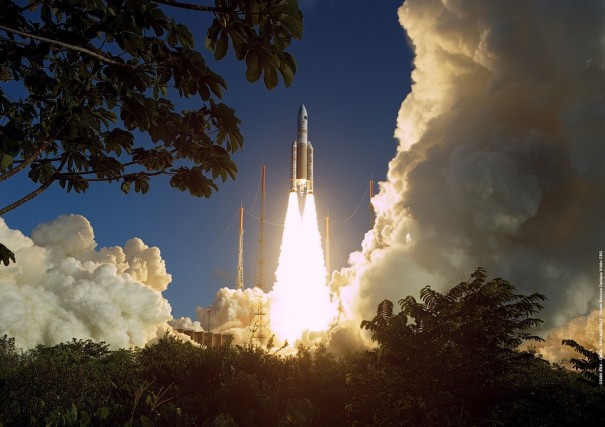Tecnologías 3D de nueva generación y distribución satelital multidispositivo, centran la presencia de Hispasat en IBC
La compañía muestra sus proyectos más vanguardistas en lo que se refiere a comunicaciones multimedia por satélite, donde destacan las tecnologías 3D de nueva generación y la distribución de contenidos satelitales a smartphones, tablets y otros dispositivos del hogar. Por otro lado, el operador anuncia que elige a Arianespace para lanzar los satélites Amazonas 4A e Hispasat AG1
En el marco IBC, Hispasat presenta sus últimas novedades en cuanto a tecnología tridimensional y distribución avanzada de contenidos en el hogar.
El operador satelital muestra sus proyectos más vanguardistas en lo que se refiere a comunicaciones multimedia por satélite, donde destacan las tecnologías 3D de nueva generación y la distribución de contenidos satelitales a smartphones, tablets y otros dispositivos del hogar.
Proyecto JEDI (Just Explore DImension)
El proyecto JEDI (Just Explore DImension) estudia la evolución de la televisión en 3D, identificando las mejores alternativas tecnológicas para su desarrollo. El canal de 3DTV JEDI, disponible en abierto a través del satélite Hispasat 1E, es el primer canal en el mundo con calidad Full HD, compatible con el nuevo estándar DVB-3DTV Phase-2a, aprobado en junio de 2012. Se trata de una potente solución que permite transmitir el mismo contenido en HD y 3D sobre el mismo canal y con mayor calidad de imagen, ahorrando ancho de banda y mejorando la experiencia de usuario.
Este novedoso canal 3DTV puede verse tanto en el stand de Hispasat como en el del grupo europeo de estandarización DVB, del cual el operador español de satélites es miembro fundador.
Proyecto Saturno
En IBC podemos también comprobar de primera mano el desarrollo del proyecto Saturno, una iniciativa que investiga y desarrolla el equipamiento necesario para la distribución de contenidos avanzados en el hogar bajo las premisas de total movilidad, calidad, flexibilidad y multidispositivo.
De esta forma, Saturno permite visualizar los contenidos de TV por satélite en todos los dispositivos del hogar (TV, tablets, smartphones, etc) sin necesidad de desplegar infraestructura en el hogar.
En su stand, Hispasat exhibe un completo demostrador de la tecnología Saturno, mediante la que múltiples dispositivos reproducen los contenidos audiovisuales recibidos vía satélite, de forma transparente para el usuario.
Hispasat elige a Arianespace para lanzar los satélites Amazonas 4A e Hispasat AG1
Carlos Espinós, consejero delegado del grupo Hispasat, y Jean-Yves Le Gall, presidente y consejero delegado de Arianespace, han anunciado este lunes en París la firma de los contratos de lanzamiento de los satélites Amazonas 4A e Hispasat AG1 en un acto al que han asistido el director general de la Agencia Espacial Europea (ESA), Jean-Jaques Dordain, y la directora de Telecomunicaciones y Aplicaciones Integradas de la misma. La puesta en órbita de estos dos satélites supone para el operador español un nuevo avance en su estrategia de crecimiento y expansión.
El Amazonas 4A será lanzado al espacio por un cohete Ariane 5 ECA o Soyuz desde el Centro Espacial Europeo de la Guayana Francesa, en Kourou, a principios de 2014. Construido a partir de una plataforma GEOStar 2.4 de Orbital Sciences Corporation, el nuevo satélite del Grupo HISPASAT se situará en la posición orbital 61º Oeste. Contará con 24 transpondedores en banda Ku y una masa de lanzamiento estimada de tres toneladas Durante sus más de 15 años de vida útil, el Amazonas 4A aportará al Grupo capacidad espacial adicional en Latinoamérica para ofrecer a sus clientes gran variedad de servicios de televisión y comunicaciones.
El Amazonas 4A será el octavo satélite de la compañía puesto en órbita por Arianespace. Con anterioridad se lanzaron los satélites Hispasat 1A y 1B en 1992 y 1993, respectivamente. En 2005 y 2006, a través de Hisdesat, se volvió a contar con Arianespace para lanzar al espacio los satélites XTAR-Eur y Spainsat. Los satélites Amazonas 2 e Hispasat 1E se pusieron en órbita en 2009 y 2010. Y en los primeros meses de 2013 Arianespace lanzará otro satélite del grupo, el Amazonas 3.
El noveno satélite de Hispasat que será lanzado por Arianespace es el Hispasat AG1, la primera misión de la plataforma Small GEO, desarrollada por OHB Systems (Alemania) con la Agencia Espacial Europea e Hispasat. Incorpora la innovadora carga útil regenerativa REDSAT, que permitirá a Hispasat utilizar de manera más ágil y eficiente la potencia del satélite, aumentando sustancialmente la capacidad de transmisión con la consiguiente reducción del coste de las comunicaciones. El Hispasat AG1, que será lanzado a finales de 2014 por un Ariane 5, contará con una masa de lanzamiento estimada de 3,2 toneladas y embarcará hasta 20 transpondedores en banda Ku y hasta 3 en banda Ka, además de una innovadora antena activa de haces reconfigurables.
Did you like this article?
Subscribe to our NEWSLETTER and you won't miss anything.




